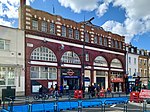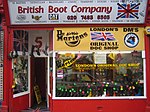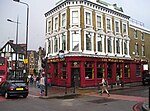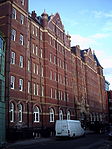The Jazz Café
Camden TownEngvarB from February 2016Jazz club stubsJazz clubs in LondonMusic venues in London ... and 3 more
Restaurants established in 1992Restaurants in LondonTourist attractions in the London Borough of Camden
The Jazz Cafe is a music venue in Camden Town, London. It opened in 1990 on the former premises of a branch of Barclays Bank and has had several owners throughout its history as a music venue. In 2020 the Jazz Cafe celebrates its 30th year, having hosted some of the most respected names in the jazz and soul world – including D’Angelo, Amy Winehouse, Adele, Roy Ayers, Bobby Womack. The venue has built a reputation for booking some of the world's biggest acts alongside local talent and rising stars. Boasting a restaurant upstairs that overlooks the stage, the venue holds 450 people across both floors.
Excerpt from the Wikipedia article The Jazz Café (License: CC BY-SA 3.0, Authors).The Jazz Café
Parkway, London Chalk Farm (London Borough of Camden)
Geographical coordinates (GPS) Address Nearby Places Show on map
Geographical coordinates (GPS)
| Latitude | Longitude |
|---|---|
| N 51.538888888889 ° | E -0.14333333333333 ° |
Address
Gap
Parkway 12
NW1 7BP London, Chalk Farm (London Borough of Camden)
England, United Kingdom
Open on Google Maps










